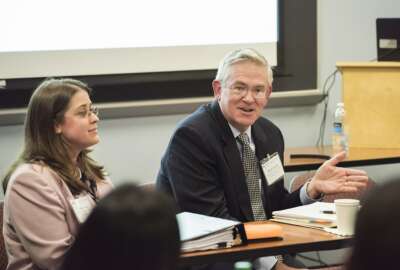
Nuclear arsenal at the ground level
Even the best plans can fail in the face of sudden policy changes. Keepers of the nuclear arsenal are scrambling.
W-88 and B-61 may not be household words, but they exemplify many of the management problems facing the government. These alpha-numeric combos are the names of nuclear weapons in the nation’s arsenal. W-88 is a submarine warhead. The B-61 is a bomb carried aloft.
Here’s the background: It falls to the National Nuclear Security Administration to manufacture the non-nuclear parts of these items in the arsenal. NNSA contracts this activity to Honeywell Federal Management and Technologies LLC. Parts-making takes place at a government-owned, contractor-operated site known as the Kansas City National Security Campus (KCNSC). The operation moved into a million-square-foot facility in 2012. While it had once been in a World War II-era building, the old place was bigger but falling apart.
Related Stories

Unaffected by shutdown, NNSA pushing ahead with hiring drive

David Trimble: NNSA facing growing challenges with even its crucial missions
We know all this from a recent Government Accountability Office study, which made no recommendations. As GAO reports go, this was no bunker buster. Just a point-by-point recitation of one small agency’s travails with a program most Americans have no idea even exists. Yet the report caught my attention because so many ongoing challenges converge there — workforce, planning and forecasting, leasing and construction costs, and national security.
If you ever want to get lost in research, try gaining a comprehensive understanding of the nuclear weapons enterprise. As the saying goes, it’s complicated. But essentially the various weapons models in the arsenal are mostly old, and they constantly need new parts — connectors, circuits, metal and plastic parts. Kansas City isn’t your average stamping plant, but rather a center of high-precision, advanced manufacturing. KCNSC must maintain up-to-date equipment and people.
KCNSC also has a significant procurement operation. The government doesn’t need to make every nut and bolt.
Auditors found the agency and its contractor aren’t doing half bad in reacting to the expanded requirements.
First of all, the NNSA didn’t leave out a spreadsheet or two in planning a new facility. The Defense Department accelerated its schedule for upgrading and modernizing the nuclear arsenal.
Second, the million square foot building was built for the General Services Administration, which leases it back to the NNSA. GAO notes this is an example of the government beholden to what it calls expensive, long-term leases. Allison Bawden, the GAO’s director of natural resources and environment issues, said the NNSA is looking at a variety of long term options, including new government construction or a commercial lease. In the meantime it will do a commercial lease of 250,000 square feet.
On the workforce side, it turns out contractors face many of the same issues as federal agencies. Honeywell’s 2,500 employees fell into a barbell pattern. At one end is highly transient young people and at the other end highly skilled but also retirement-eligible people. A strong manufacturing economy, the sluggish security clearance process and the exacting training requirements for making bomb bits all conspire against recruitment and retention.
Honeywell is recruiting at high schools, colleges and trade schools. It’s joined manufacturing consortia. It plans to expand its internship program. It’s established special, non-secured facilities where people can do useful work while awaiting their clearance to come through. It even persuaded the Office of Personnel Management to establish a small presence at Kansas City to help expedite clearances. It’s offering would-be retirees the option of what the government would call phased retirement.
The NNSA itself is working more closely with DoD counterparts on development of new versions of the B-61 and W-88 to limit constant design changes that expand early stages but squeeze things down the line.
See how decisions made in Washington translate down the line so that a facility in Kansas City must get creative to do the work.
Copyright © 2024 Federal News Network. All rights reserved. This website is not intended for users located within the European Economic Area.
Tom Temin is host of the Federal Drive and has been providing insight on federal technology and management issues for more than 30 years.
Follow @tteminWFED




